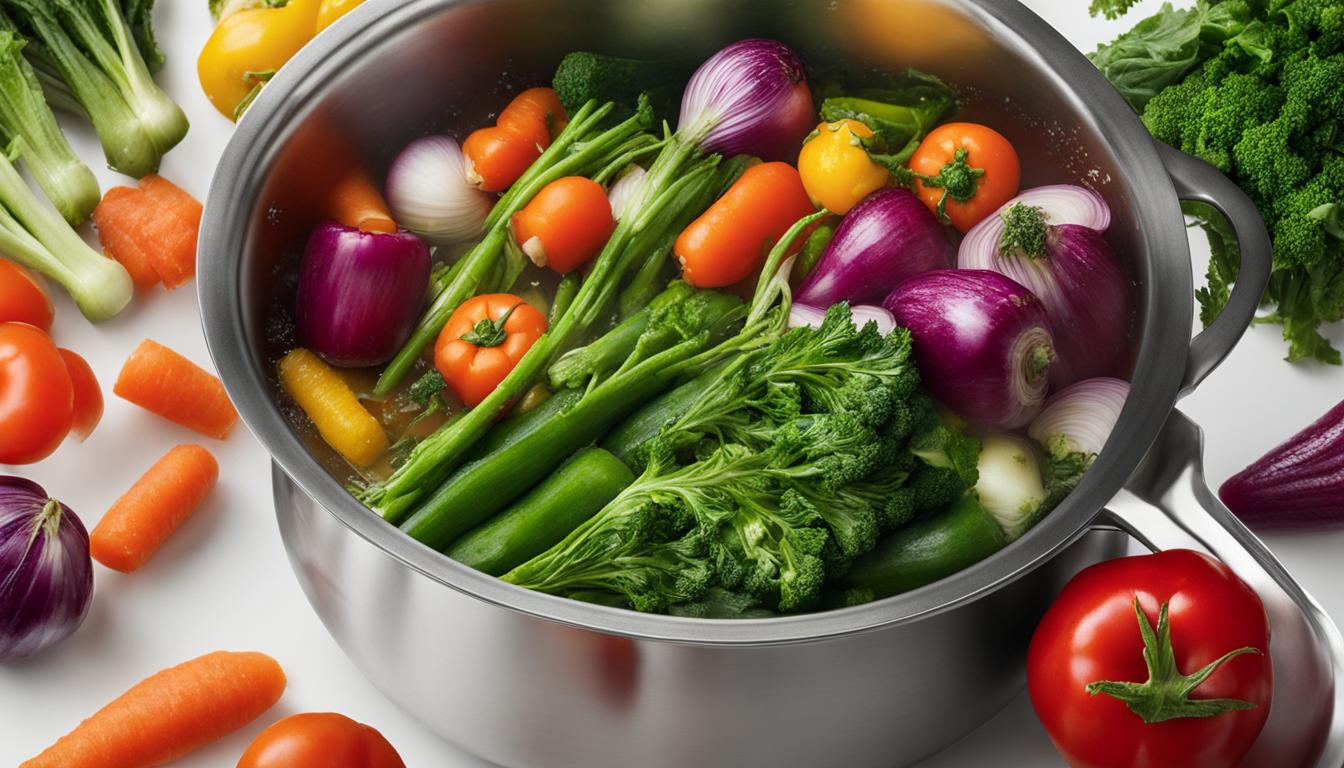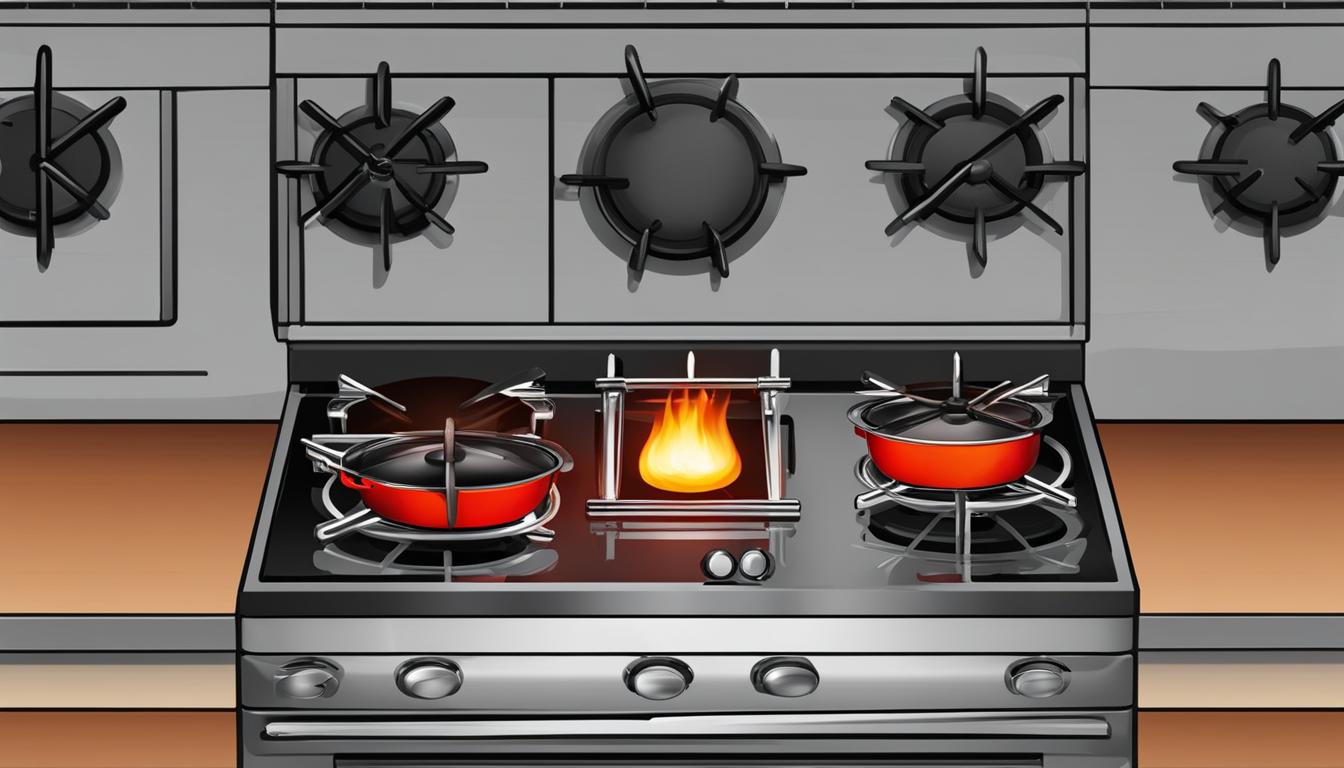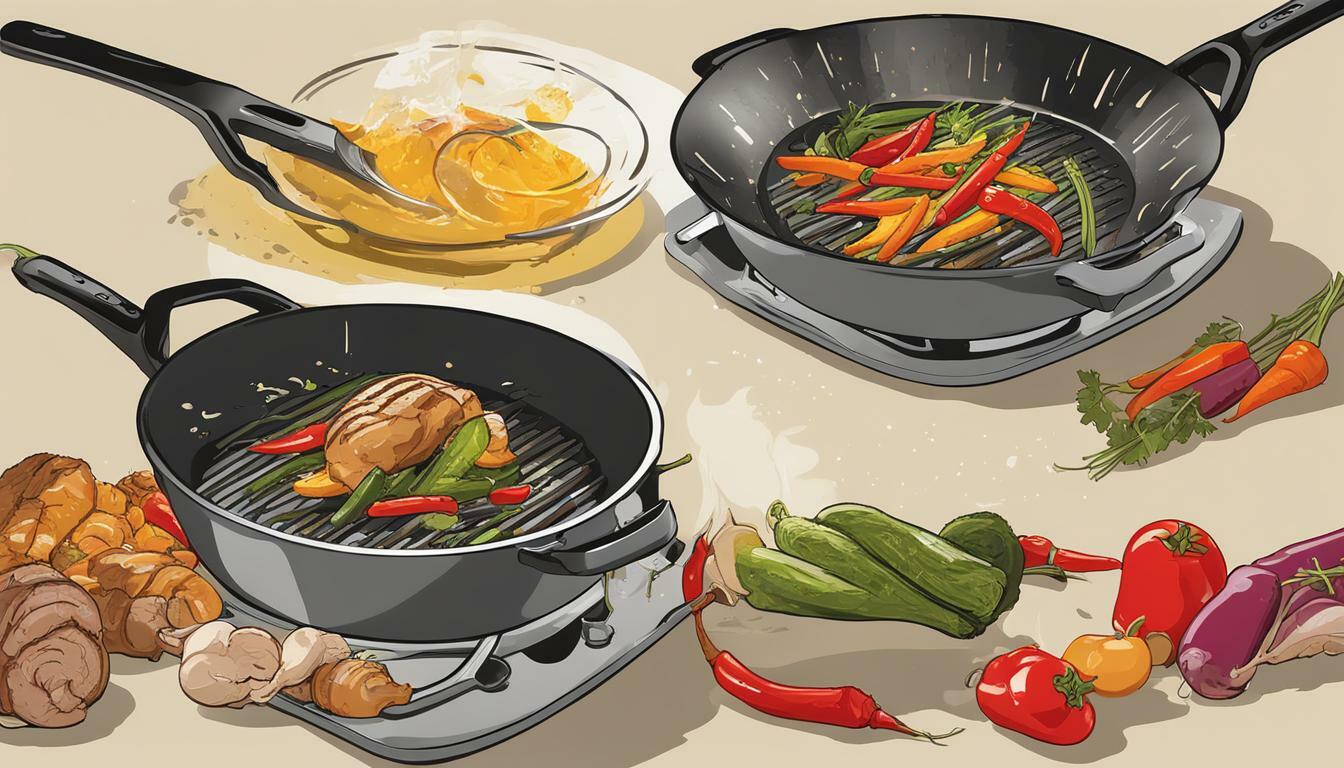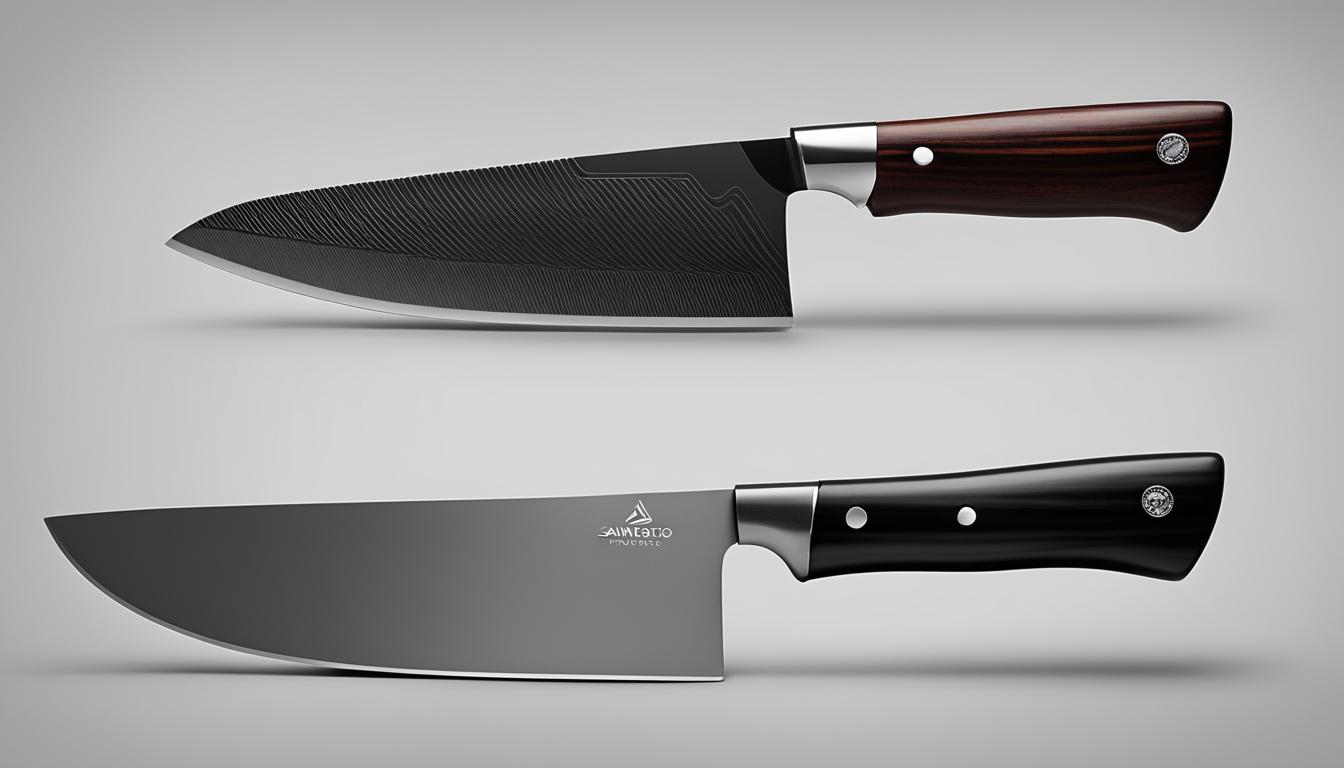Blanching and parboiling are two cooking techniques that are often used interchangeably, but they have distinct differences in their process and purpose. Understanding these differences is essential for achieving the desired results in your culinary endeavors.
Blanching involves briefly boiling an ingredient and then immersing it in ice water to preserve its color and texture. This method is commonly employed to blanch vegetables before serving or freezing them. On the other hand, parboiling is the process of partially boiling an ingredient, which is then finished cooking using another method. It is often used to pre-cook food items before grilling, stewing, or stir-frying them.
Key Takeaways:
- Blanching involves briefly boiling an ingredient and then immersing it in ice water to preserve its color and texture.
- Parboiling is the process of partially boiling an ingredient, which is then finished cooking using another method.
- Blanching is commonly used for vegetables before serving or freezing them, while parboiling is often used to pre-cook food items before using another cooking method.
- Blanching helps preserve the color and texture of vegetables, while parboiling speeds up the overall cooking time and ensures even cooking.
- Understanding the differences between blanching and parboiling allows you to use these techniques effectively in your cooking.
What is Blanching?
Blanching is a culinary technique used to preserve the color and texture of vegetables. It involves briefly boiling the vegetables and then rapidly cooling them to halt enzymatic processes that cause deterioration in flavor, color, and texture over time. The blanching process helps retain the natural freshness of vegetables, making them more visually appealing and maintaining their nutritional value.
To blanch vegetables, start by bringing a pot of water to a rolling boil. Add the vegetables to the boiling water and cook them for a short period, typically 1 to 3 minutes, depending on the vegetable’s thickness. After the blanching time is complete, remove the vegetables from the boiling water and immediately transfer them to an ice water bath. The ice water bath rapidly cools the vegetables, stopping the cooking process and preserving their vibrant color and crispness.
Blanching is commonly used for various vegetables, such as green beans, broccoli, carrots, and peas. It is an essential step before freezing vegetables to maintain their quality and prevent the loss of color and texture during the freezing process. Blanching can also be used in recipes that require pre-cooked vegetables, ensuring they remain vibrant and retain their natural characteristics throughout the cooking process.
Table: Blanching vs. Boiling
| Blanching | Boiling |
|---|---|
| Vegetables are briefly cooked in boiling water. | Ingredients are fully cooked in boiling water. |
| Rapidly cooled in ice water to preserve color and texture. | No rapid cooling step involved. |
| Preserves vibrant color and crispness. | No preservation of color or texture. |
| Used for freezing, salads, or pre-cooking vegetables. | Used for fully cooking ingredients. |
How to Blanch Vegetables
Blanching vegetables is a simple and effective technique that helps preserve their color, texture, and nutritional value. By following a few easy steps, you can blanch your vegetables to perfection.
Step 1: Prepare the Vegetables
Start by selecting fresh, high-quality vegetables. Wash them thoroughly to remove any dirt or debris. Trim off any stems or tough ends and cut the vegetables into uniform pieces to ensure even blanching.
Step 2: Blanch the Vegetables
Bring a large pot of water to a rolling boil. Add a tablespoon of salt per gallon of water to enhance the flavor of the vegetables. Carefully place the vegetables into the boiling water using tongs or a slotted spoon. Blanch the vegetables for a short time, typically 1 to 3 minutes, depending on the vegetable’s size and density.
It’s essential to blanch the vegetables in small batches to maintain the boiling temperature. Overcrowding the pot can result in uneven blanching and longer cooking times.
Step 3: Cool and Drain the Vegetables
After blanching, quickly transfer the vegetables to a large bowl filled with ice water. This rapid cooling process, known as shocking, halts the cooking process and helps retain the vibrant color and crispness of the vegetables.
Once the vegetables have cooled for a few minutes, drain them thoroughly to remove excess moisture. Pat them dry with a clean kitchen towel or paper towels before using or storing them.
Recommended Blanching Times for Common Vegetables
| Vegetable | Blanching Time |
|---|---|
| Broccoli florets | 2 to 3 minutes |
| Carrot slices | 2 minutes |
| Green beans | 2 minutes |
| Cauliflower florets | 2 minutes |
| Corn on the cob | 4 minutes |
These times are general guidelines and may vary depending on the size and maturity of the vegetables. It’s always best to test a piece of the vegetable before removing it from the boiling water to ensure it’s cooked to your desired texture.
Blanching vegetables is a valuable technique that enhances the taste, appearance, and quality of your dishes. Whether you’re preparing fresh vegetables for immediate consumption or freezing them for future use, blanching is a reliable method to preserve their best qualities. Incorporate blanched vegetables into your favorite recipes to enjoy the vibrant colors, crisp textures, and heightened flavors they bring to every dish.
What is Parboiling?
Parboiling is a cooking method that involves partially boiling an item to speed up the cooking time in another method. It is commonly used for ingredients like rice, potatoes, or vegetables that need to be pre-cooked before finishing them in another cooking method such as boiling, stewing, grilling, or stir-frying. Parboiling does not involve the rapid cooling step like blanching does.
Parboiling Process
The parboiling process consists of three simple steps. First, the food item is placed in boiling water and cooked until it begins to soften. The cooking time can vary depending on the specific item being parboiled. Then, the food is removed from the boiling water and immediately finished cooking using the desired method, such as roasting, grilling, or pan frying. Parboiling is a useful technique for ensuring that all ingredients in a dish are cooked properly, especially when some ingredients take longer to cook than others.
Parboiling offers several benefits in cooking. It helps speed up the overall cooking time, particularly for ingredients that require a longer cooking period. By partially cooking the item before finishing it using another method, parboiling ensures that the ingredients are evenly cooked and have a consistent texture. This is especially useful when cooking dishes like sheet pan dinners or preparing large batches of pre-cooked ingredients for meal prepping.
| Benefits of Parboiling |
|---|
| Speeds up cooking time |
| Ensures even cooking |
| Helps maintain consistent texture |
Parboiling is a versatile cooking technique that can be applied to a variety of ingredients. Whether you’re preparing rice for a flavorful pilaf, potatoes for crispy roasted potatoes, or vegetables for a stir-fry, parboiling can help make your cooking process more efficient and ensure delicious results.
How to Parboil
Parboiling is a simple three-step process that helps ensure all ingredients in a dish are cooked properly, especially when some ingredients take longer to cook than others. Follow these steps to parboil your ingredients:
- First, place the food item in boiling water and cook until it begins to soften. The cooking time may vary depending on the item being parboiled. For example, potatoes may take around 5-7 minutes, while cauliflower may take around 2-3 minutes.
- Once the food is partially cooked, remove it from the boiling water immediately to prevent overcooking. You can use tongs or a slotted spoon to carefully lift the food out of the water.
- Finally, finish cooking the food using your desired method. This could include roasting, grilling, or pan frying. The parboiling process ensures that the ingredients are evenly cooked and have a consistent texture.
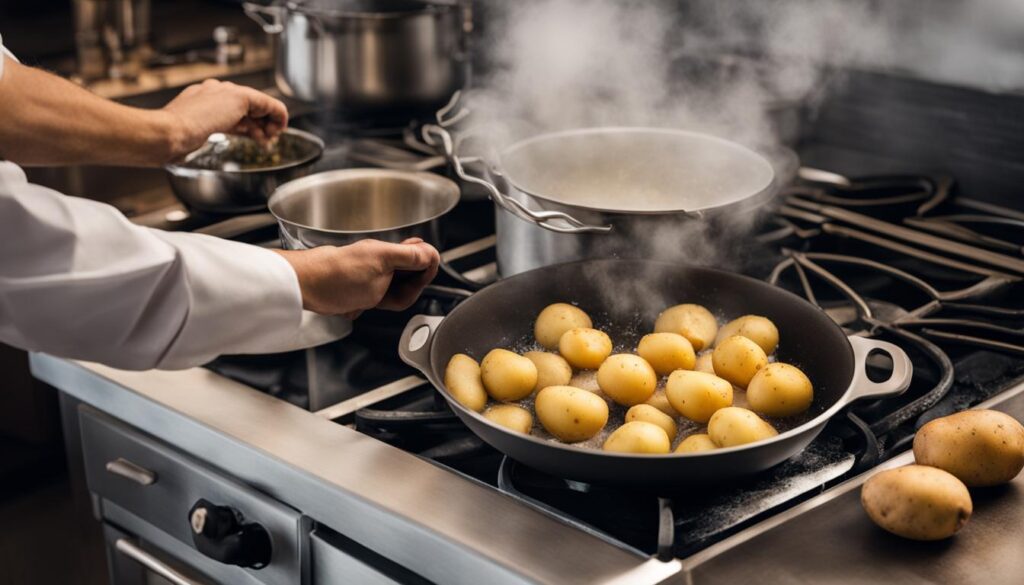
Example Parboiling Times:
Here are some approximate parboiling times for common ingredients:
| Ingredient | Parboiling Time |
|---|---|
| Potatoes (cubed) | 5-7 minutes |
| Pasta | 3-4 minutes |
| Carrots (sliced) | 2-3 minutes |
| Cauliflower (florets) | 2-3 minutes |
Remember to adjust the parboiling times based on your personal preference and the desired level of doneness for your ingredients. With proper parboiling, you can achieve evenly cooked and delicious dishes every time!
Why Blanch Vegetables?
Blanching vegetables offers several benefits in the kitchen. One of the main advantages is the preservation of color and texture. By briefly boiling vegetables and then immersing them in ice water, blanching helps retain the vibrant colors and crisp textures of the produce. This is particularly useful when freezing fresh vegetables for longer storage, as blanching helps prevent enzymatic browning and maintains the overall quality of the vegetables.
Another benefit of blanching is the ability to easily remove the skins of certain produce, such as peaches or tomatoes, without fully cooking them. This is advantageous for recipes that require skinless fruits or vegetables, providing a smoother texture and enhancing the overall presentation of the dish.
Additionally, blanching is a helpful technique for preserving the flavor and nutritional value of vegetables. By halting the enzymatic processes that cause color, flavor, and texture loss, blanching helps retain the natural freshness and vitality of the vegetables, ensuring a more enjoyable dining experience.
The Benefits of Blanching Vegetables:
- Preserves color and texture
- Prevents enzymatic browning
- Retains flavor and nutritional value
- Eases removal of skins for certain produce
Blanching provides a simple yet effective method for maintaining the quality of vegetables and enhancing their visual appeal. Whether you’re preparing vegetables for immediate consumption or for long-term storage, blanching is a valuable technique to incorporate into your culinary repertoire.
Why Do You Parboil?
Parboiling offers several benefits in the cooking process. One of the main advantages is the ability to speed up the overall cooking time. By partially boiling the ingredients before finishing them in another cooking method, parboiling reduces the time it takes to fully cook the food. This is especially useful for items that require a longer cooking period, such as large cuts of meat or dense vegetables.
Another benefit of parboiling is that it helps ensure even cooking throughout the dish. By pre-cooking the ingredients to a certain point, parboiling allows for more consistent cooking, resulting in an evenly cooked and well-balanced meal. This is particularly important when preparing dishes like sheet pan dinners or casseroles, where different ingredients may have varying cooking times.
Overall, parboiling is a valuable technique that can enhance the cooking process. It not only speeds up cooking times but also promotes even cooking and consistent results. By incorporating parboiling into your culinary repertoire, you can elevate your dishes and create delicious meals with ease.
Table: Comparing Blanching and Parboiling
| Blanching | Parboiling | |
|---|---|---|
| Definition | Preserving color and texture of vegetables | Partially boiling ingredients to speed up cooking time |
| Main Purpose | Preserve color, texture, and flavor of vegetables | Reduce overall cooking time |
| Process | Boiling briefly and then immersing in ice water | Boiling partially and then finishing with another cooking method |
| Commonly Used For | Vegetables before serving or freezing | Rice, potatoes, or vegetables before grilling, stewing, or stir-frying |
| Advantages | Preserves color, texture, and flavor; removes skins without cooking | Speeds up cooking time; ensures even cooking |
Conclusion
In conclusion, blanching and parboiling are two distinct cooking techniques that serve different purposes in the kitchen. Blanching is primarily used to preserve the color and texture of vegetables, making it an ideal method for preparing vegetables before freezing or incorporating them into salads. On the other hand, parboiling is employed to partially cook ingredients and expedite the overall cooking process in subsequent methods such as grilling, stewing, or stir-frying.
Blanching involves briefly boiling an ingredient and then quickly cooling it in an ice water bath, while parboiling requires partially boiling an item and finishing its cooking using another method. Both techniques have their unique advantages. Blanching helps retain the natural qualities of vegetables, preventing color, flavor, and texture loss over time. Meanwhile, parboiling accelerates cooking time and ensures even cooking, making it suitable for ingredients that require longer cooking periods.
Whether you choose to blanch or parboil, these techniques can greatly enhance your dishes by maintaining the quality of ingredients and improving overall cooking efficiency. Incorporate these methods into your culinary repertoire and elevate your cooking game to new heights.
FAQ
How does blanching differ from parboiling?
Blanching involves briefly boiling an ingredient and then immersing it in ice water to preserve its color and texture. Parboiling is the process of partially boiling an ingredient, which is then finished cooking using another method.
What is blanching?
Blanching is a cooking technique used to preserve the color and texture of vegetables. It involves briefly boiling the vegetables and then immediately cooling them in an ice water bath.
How do you blanch vegetables?
Blanching vegetables involves briefly plunging them into boiling water and then quickly transferring them to an ice water bath to preserve their color and texture.
What is parboiling?
Parboiling is a cooking method that involves partially boiling an item to speed up the cooking time in another method.
How do you parboil?
Parboiling involves placing the food item in boiling water and cooking it until it begins to soften. It is then immediately finished cooking using the desired method.
Why should you blanch vegetables?
Blanching vegetables helps preserve their color and natural texture, preventing them from losing quality over time. It is particularly useful when freezing fresh vegetables for longer storage.
Why do you parboil?
Parboiling helps speed up the overall cooking time, ensuring that all ingredients in a dish are cooked properly. It is especially useful when cooking dishes with ingredients that have varying cooking times.
 Skip to main content
Skip to main content